Study on Roof-Cutting and Support of a Retreating Roadway under the Double Influence of Large Mining Heights
Abstract
:1. Introduction
2. Project Overview
2.1. Geological Conditions
2.2. Overview of the Original Evacuation Lane Support
2.3. Theoretical Calculation of Support
3. Model Establishment and Support Analysis
3.1. Establishment of Model and Boundary Conditions
3.2. Roadway Support Simulation Analysis
3.2.1. Surrounding Rock Stress Simulation
3.2.2. Support Simulation Analysis of Retracement Roadway
4. Cutting Top Analysis and Constant Resistance Anchor Cable Support
4.1. Determination of Important Parameters of the Cutting Top
4.1.1. Theoretical Calculation of Top Cutting Pressure Relief Angle
4.1.2. Theoretical Calculation of Top Cutting Relief Height
4.2. Bidirectional Energy-Cavity Blasting Technology
4.3. Roof Cutting Simulation Analysis
4.4. Stress Compensation Support of Constant Resistance and Large Deformation Anchor Cable
5. Monitoring Site Layout and Monitoring Analysis
6. Conclusions
Author Contributions
Funding
Institutional Review Board Statement
Informed Consent Statement
Data Availability Statement
Acknowledgments
Conflicts of Interest
References
- Tao, Z.; Song, Z.; He, M.; Meng, Z.; Pang, S. Principles of the roof cut short-arm beam mining method (110 method) and its mining-induced stress distribution. Int. J. Min. Sci. Technol. 2018, 28, 391–396. [Google Scholar] [CrossRef]
- Sun, X.; He, M. Numerical Simulation Research on Coupling Support Theory of Roadway Within Soft Rock at Depth. J. China Univ. Min. Technol. 2005, 2, 37–40. [Google Scholar]
- Jiang, Z.; Jiang, B.; Zhang, C.; Ma, Y.; Wang, Y.; Li, D.; Wang, S. Research on cooperative control method of comprehensive pressure relief and anchor grouting reinforcement in deep mining roadways. Geomech. Geophys. Geo-Energy Geo-Resour. 2024, 10, 79. [Google Scholar] [CrossRef]
- Han, C.; Zhang, N.; Yang, H.; Zhao, Q.; Song, K. Discontinuous Deformation Characteristics of Deep Buried Roadway Roofs and Linkage Control of Thick Layer Cross-Boundary Anchorage: A Case Study. Energies 2023, 16, 2160. [Google Scholar] [CrossRef]
- Cui, J.; Wang, W.; Chao, Y. Application of stability analysis in surrounding rock control and support model of deep roadway. Int. J. Oil Gas Coal Technol. 2021, 29, 180–192. [Google Scholar] [CrossRef]
- Babets, D.; Babets, D.; Sdvyzhkova, O.; Hapieiev, S.; Shashenko, O.; Prykhodchenko, V. Multifactorial analysis of a gateroad stability at goaf interface during longwall coal mining—A case study. Min. Miner. Depos. 2023, 17, 9–19. [Google Scholar] [CrossRef]
- Pang, S. Design and Practical of Equipment remove Gateway of Fully Mechanized Coal Mining Working Face with Super Mining Height 8. 2 m. Coal Min. 2018, 4, 45–49. [Google Scholar]
- Rabcewicz, L. The new Austrian tunnelling method. Water Power 1964, 11, 453–457. [Google Scholar]
- Hou, C.; Wang, X.; Bai, J.; Meng, N.; Wu, W. Basic theory and technology study of stability control for surrounding rock in deep roadway. J. China Univ. Min. Technol. 2021, 1, 1–12. [Google Scholar]
- Liu, X.; Hua, X.; Liang, Y.; Li, C. Quantitative Research on Roof Deformation and Temporary Support Stiffness in Deep-Mine Gob-Side Entry Retaining by Roof Cutting. Appl. Sci 2024, 14, 6520. [Google Scholar] [CrossRef]
- Yue, X.; Tu, M.; Li, Y.; Chang, G.; Li, C. Stability and cementation of the surrounding rock in roof-cutting and pressure-relief entry under mining influence. Energies 2022, 13, 951. [Google Scholar] [CrossRef]
- Xue, H.; Wang, Q.; Jiang, B.; Jiang, Z.; Wang, Y.; Huang, Y.; He, M. Study on the method of pressure relief by roof cutting and absorbing energy in deep coal mines. Bull. Eng. Geol. Environ. 2023, 82, 298. [Google Scholar] [CrossRef]
- Xiong, J.; Yang, T.; Yang, Y. Key parameters of roof cutting along the dip in withdrawing face. Coal Eng. 2023, 8, 68–72. [Google Scholar]
- He, C.; Xu, X.; Yang, J.; Ding, W.; Wang, Z.; Wang, Y.; Chen, F. Surrounding rock deformation control for roof cutting and pressure relief under thick and hard roof. Coal Eng. 2022, 9, 59–63. [Google Scholar]
- Guo, J.; Li, Y.; Shi, S.; Jiang, Y.; Cheng, D.; He, F.; Xie, S. Self-forming roadway of roof cutting and surrounding rock control technology under thick and hard basic roof. J. China Coal Soc. 2021, 46, 2853–2864. [Google Scholar]
- Wang, J.; Zhu, D.; Gong, W.; He, M.; Gao, R. Physical simulation experiment on the movement of rock strata upon automatic roadway forming by roof cutting and pressure releasing. Chin. J. Rock Mech. Eng. 2018, 11, 2536–2547. [Google Scholar]
- Li, Z.; Tao, Z.; Meng, Z.; He, M. Longwall mining method with roof-cutting unloading and numerical investigation of ground pressure and roof stability. Arab.J. Geosci. 2018, 11, 697. [Google Scholar] [CrossRef]
- Wang, Q.; Zhang, P.; Jiang, Z.; He, M.; Li, S.; Wang, Y.; Jiang, B. Automatic roadway formation method by roof cutting with high strength bolt-grouting in deep coal mine and its validation. Coal J. 2021, 2, 382–397. [Google Scholar]
- Wang, Q.; Liu, J.; Jiang, B.; Xue, H.; Gao, H.; Jiang, Z. Research on control methods of automatically-formed roadway without coal pillar for extremely close-distance coal seams. J. Min. Strat. Control Eng. 2024, 1, 22–37. [Google Scholar]
- Liu, X.; Hua, X.; Yang, P.; Huang, Z. A study of the mechanical structure of the direct roof during the whole process of non-pillar gob-side entry retaining by roof cutting. Energy Explor. Exploit. 2020, 38, 1706–1724. [Google Scholar] [CrossRef]
- Guo, Z.; Li, W.; He, M.; Tang, J. Failure mechanisms and control strategies in dynamic pressure roadways of deep soft rock based on compensation theory. J. China Univ. Min. Technol. 2023, 5, 931–942. [Google Scholar]
- Hou, G.; Hu, T.; Li, Z.; Li, Z.; Cheng, J.; Cui, Y. Effect of cutting roof height on the stability of gob-side retaining roadway with roadside support. J. Min. Saf. Eng. 2019, 36, 925–931. [Google Scholar]
- He, M.; Ma, Z.; Guo, Z.; Chen, S. Key parameters of the gob-side entry retaining formed by roocutting and pressure release in deep medium thickness coal seams. J. China Univ. Min. Technol. 2018, 3, 468–477. [Google Scholar]
- Liu, H.; Zhao, Y.; Ren, T.; Wang, F.; Li, Z. Characteristics of overburden failure and fracture developmentin gob of mining with gob side entry formed by cutting roof. J. China Univ. Min. Technol. 2022, 1, 77–89. [Google Scholar]
- Wang, Y. Parameter design and engineering application of directional blasting for roof cutting pressure relief of waterproof coal pilla. Coal Eng. 2024, 2, 1–9. [Google Scholar]
- Bednarek, Ł.; Małkowski, P.; Niedbalski, Z.; Mucha, K. Steel Arch and Rock Bolt Support in Terms of the Gateroad Stability Maintaining behind the Longwall Face. Appl. Sci 2024, 14, 3594. [Google Scholar] [CrossRef]
- Chen, S.; Zhao, F.; Wang, H.; Yuan, G.; Guo, Z.; Yang, J. Determination of key parameters of gob-side entry retaining by cutting roof and its application to a deep mine. Rock Soil Mech. 2019, 1, 332–342+350. [Google Scholar]
- Yang, X.; Liu, C.; Ji, Y.; Ji, Y.; Zhang, X.; Wang, S. Research on Roof Cutting and Pressure Releasing Technology of Directional Fracture Blasting in Dynamic Pressure Roadway. Geotech. Geol. Eng. 2019, 37, 1555–1567. [Google Scholar] [CrossRef]
- Vu, T. Solutions to prevent face spall and roof falling in fully mechanized longwall at underground mines. Min. Miner. Depos. 2022, 16, 127–134. [Google Scholar] [CrossRef]
- Cheng, J.; Wei, Z.; Bai, J.; Yu, Z.; Xing, K.; Li, Q.; Wang, Y.; Li, X.; Zhang, Z.; Zhang, Z. Study on floor heave control technology of deep tectonic stress water-rich soft rock roadway based on blasting pressure relief. Coal Sci. Technol. 2022, 50, 117–126. [Google Scholar]
- Peng, L.; Yue, N.; An, L.; Li, S.; Cai, F.; Feng, Z.; Li, M. Study on support of retractable channel in fully-mechanized miningface with super large mining height. Coal Sci. Technol. 2022, 6, 204–210. [Google Scholar]
- Xie, S.; Wu, Y.; Guo, F.; Zou, H.; Chen, D.; Zhang, X.; Ma, X.; Liu, R.; Wu, C. Application of pre-Splitting and roof-cutting control technology in coal mining: A review of technology. Energies 2022, 15, 6489. [Google Scholar] [CrossRef]
- Zhu, Q.; Xue, F.; Bai, G.; Li, T.; Wang, B.; Zhao, J. An exploration of improving the stability of mining roadways constructed in soft rock by roof cutting and stress transfer: A case study. Eng. Fail. Anal. 2024, 157, 107898. [Google Scholar] [CrossRef]
- Gao, Y.; Yang, J.; Zhang, X.; Xue, H.; He, M. Study on surrounding rock control of roadways in deep coal mines based on roof cutting and pressure release technology by directional tensile blasting. Chin. J. Rock Mech. Eng. 2019, 38, 2045–2056. [Google Scholar]
- Yang, Y. Research on the Support Technology of CompositeRoof Retraction Passage with Ooze Invasionin Multi-hole Karst Area. Master’s Thesis, Taiyuan University of Technology, Taiyuan, China, 2020. [Google Scholar]
- Yang, J.; Wei, Q.; Wang, Y.; Gao, Y.; Hou, S.; Qiao, B. Roof deformation mechanism and control measures of pillarless mining with gob-side entry retaining by roof cutting and pressure relief. Rock Soil Mech. 2020, 41, 989–998. [Google Scholar]
- He, M.; Song, Z.; Wang, A.; Yang, H.; Qi, H.; Guo, Z. Theory of longwall mining by using roof cuting shortwall team and 110 method—The third mining science and technology reform. Coal Technol. 2017, 1, 1–9+13. [Google Scholar]
- Han, Z.; Huang, Y.; Li, J.; Zayzay, S., Jr.; Guo, H. Study on key parameters of roof cutting and pressure release in medium-thickness coal seam. Geotech. Geol. Eng. 2019, 12, 3413–3422. [Google Scholar] [CrossRef]
- Liu, S. Research and application of bidirectional shaped tensile forming blasting technology. Shandong Coal Sci. Technol. 2013, 4, 175–177. [Google Scholar]
- Cho, S.; Nakamura, Y.; Mohanty, B.; Yang, H.; Kaneko, K. Numerical study of fracture plane control in laboratory-scale blasting. Eng. Fract. Mech. 2008, 75, 3966–3984. [Google Scholar] [CrossRef]
- Zhang, X.; Hu, J.; Xue, H.; Mao, W.; Gao, Y.; Yang, J.; He, M. Innovative approach based on roof cutting by energy-gathering blasting for protecting roadways in coal mines. Tunn. Undergr. Space Technol. 2020, 99, 103387. [Google Scholar] [CrossRef]
- Liu, J.; Li, D.; Chen, X.; Wang, S.; Wang, H.; Xu, Y. Overburden stress arch elevation effect induced by roof cutting and destress technique in coal mine longwall panel and its control mechanism to entry surrounding rock. Min. Metall. Explor. 2023, 40, 1237–1252. [Google Scholar] [CrossRef]
- Chen, S.; Zhao, B.; Zhao, F.; Yuan, G.; Wang, H.; Wang, X.; Guo, Z. Mechanical characteristics of constant resistance and large deformation anchor cable and its application in deep gob-side entry retaining by roof cutting. Coal Eng. 2020, 11, 103–107. [Google Scholar]
- Wang, J.; Liu, P.; He, M.; Tian, H.; Gong, W. Mechanical Behaviour of a Deep Soft Rock Large Deformation Roadway Supported by NPR Bolts: A Case Study. Rock Mech. Rock Eng. 2023, 56, 8851–8867. [Google Scholar] [CrossRef]
- Wang, Q.; Jiang, Z.; Jiang, B.; Gao, H.; Huang, Y.; Zhang, P. Research on an automatic roadway formation method in deep mining areas by roof cutting with high-strength bolt-grouting. Int. J. Rock Mech. Min. Sci. 2020, 128, 104264. [Google Scholar] [CrossRef]
- Lv, K.; Zhao, Z.; Zhao, Z. Study on support technology of equipment removal channel in fully-mechanized top coal caving face in ultra—Thick seam. Coal Sci. Technol. 2018, 3, 39–43. [Google Scholar]
- Jing, H.; Wu, J.; Yin, Q.; Wang, K. Deformation and failure characteristics of anchorage structure of surrounding rock in deep roadway. Int. J. Min. Sci. Technol. 2020, 5, 593–604. [Google Scholar] [CrossRef]


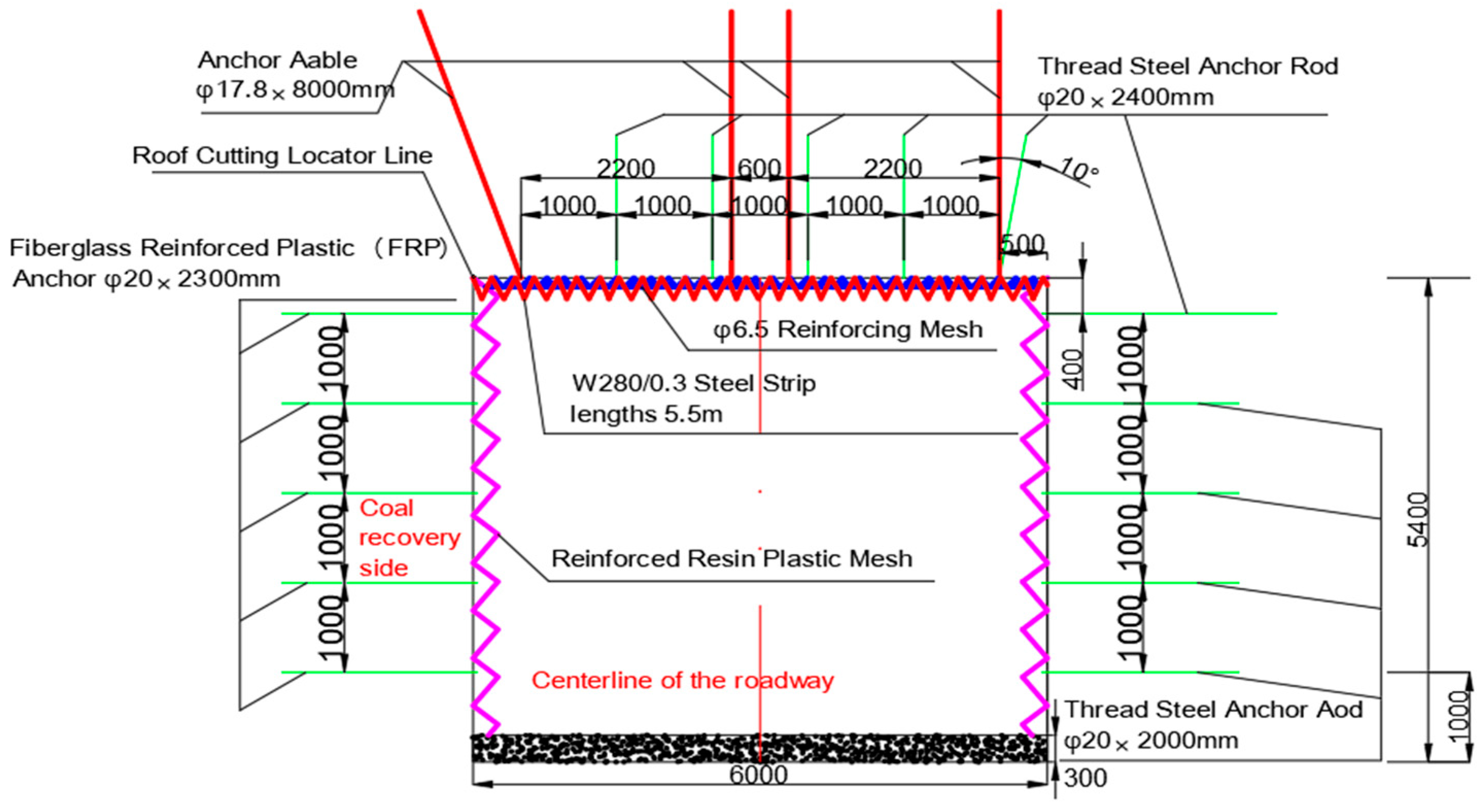

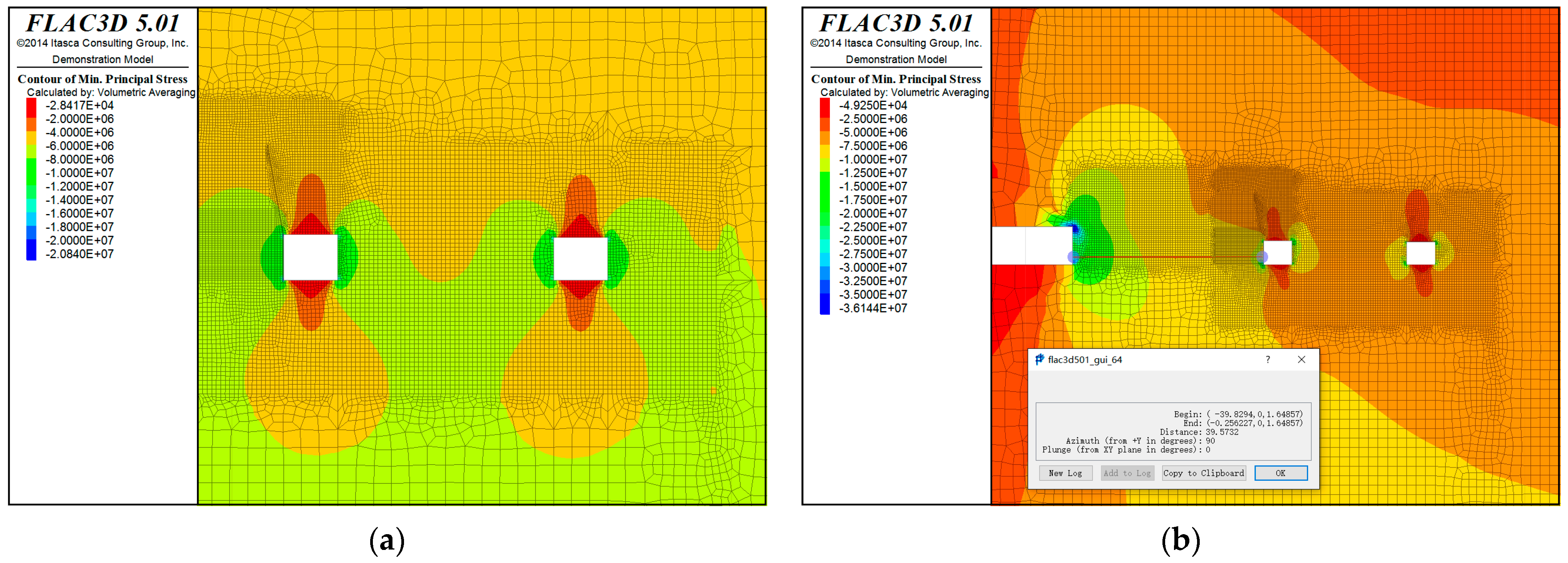
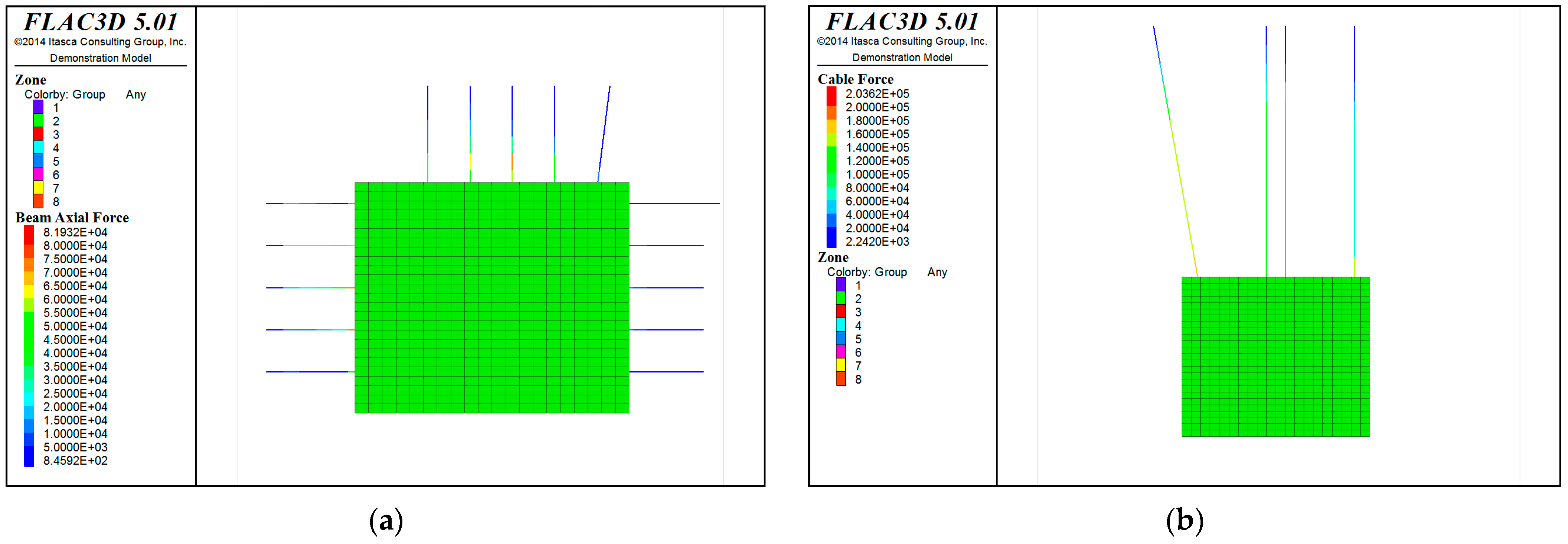

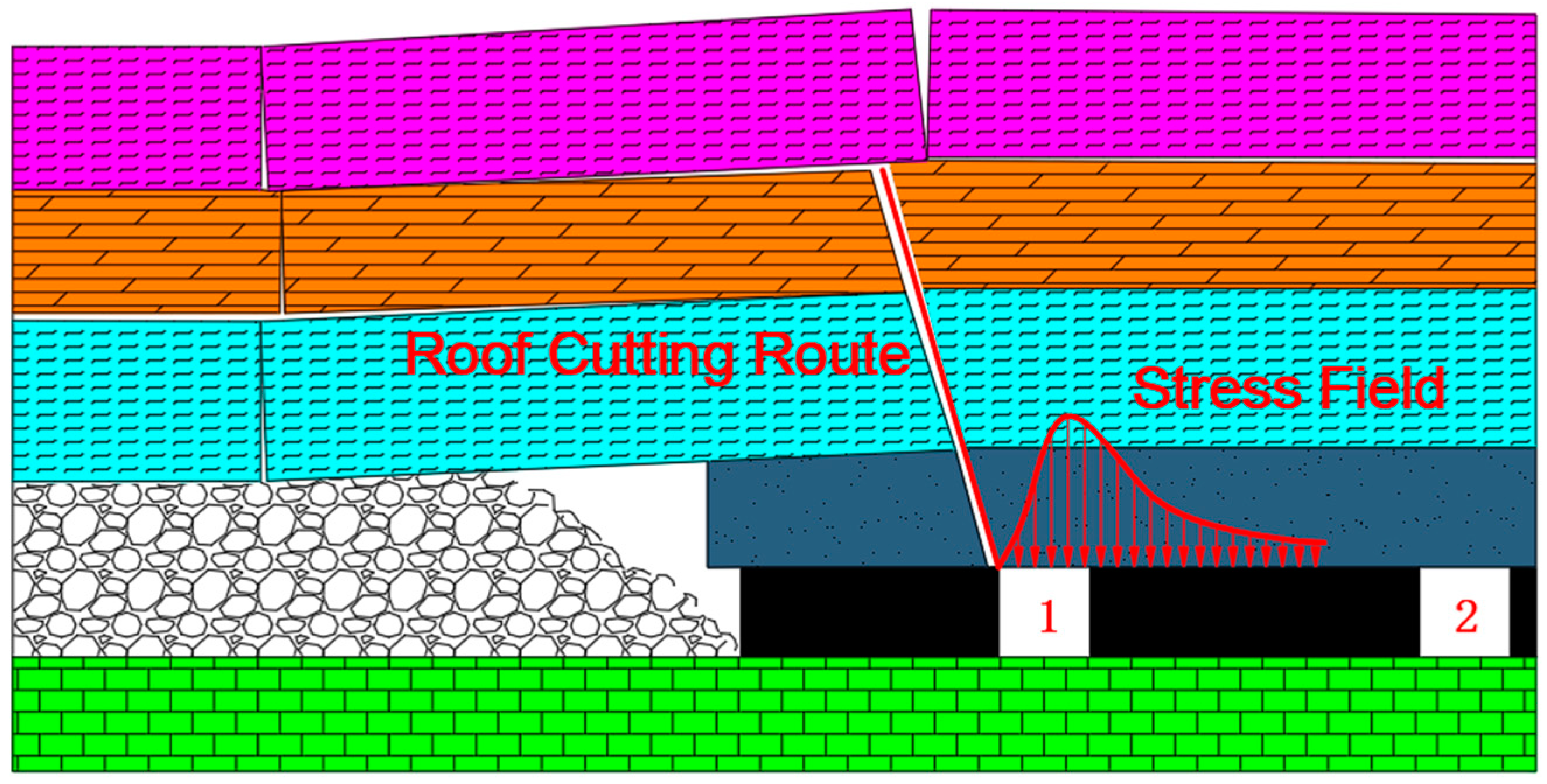
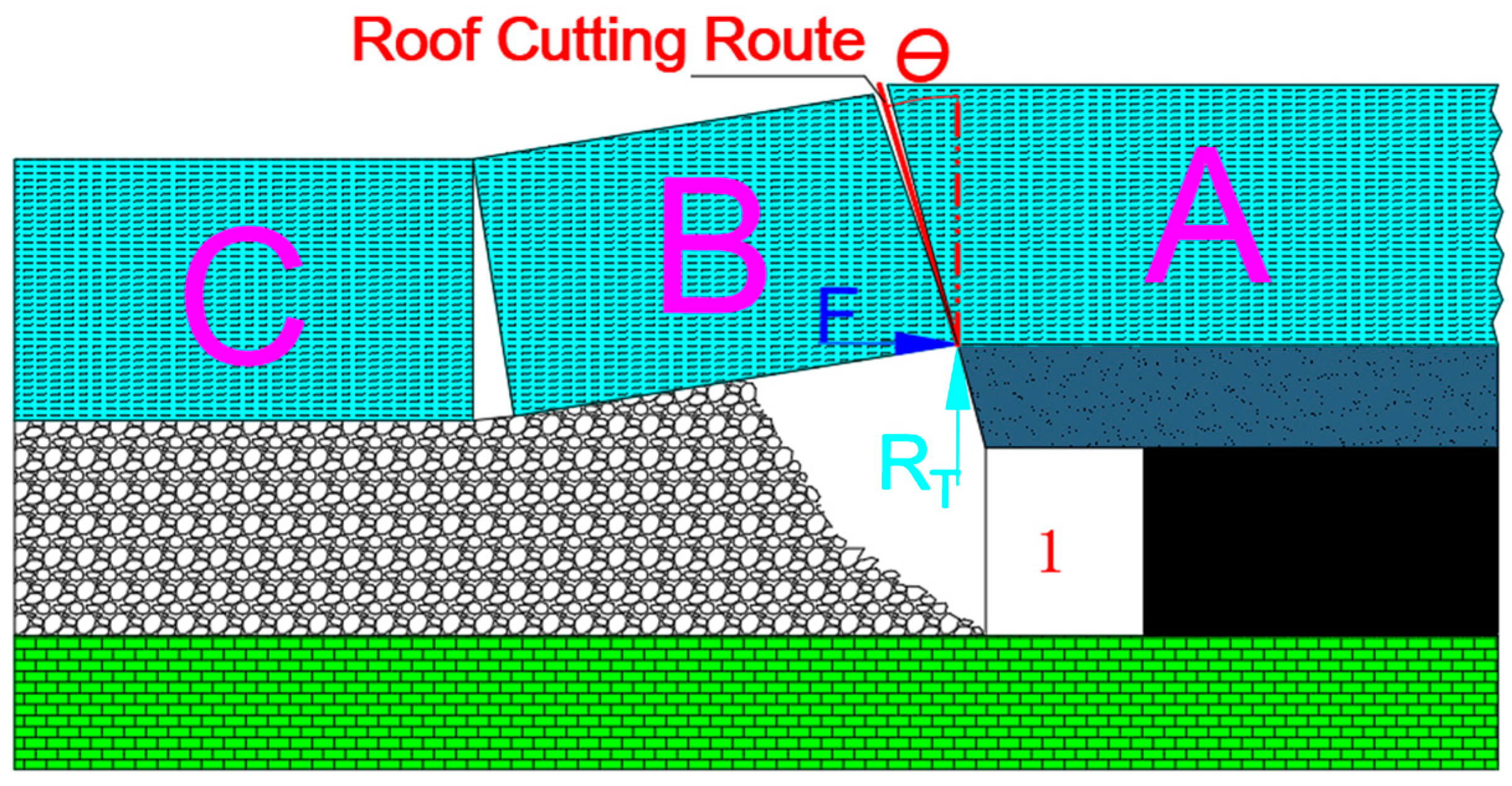

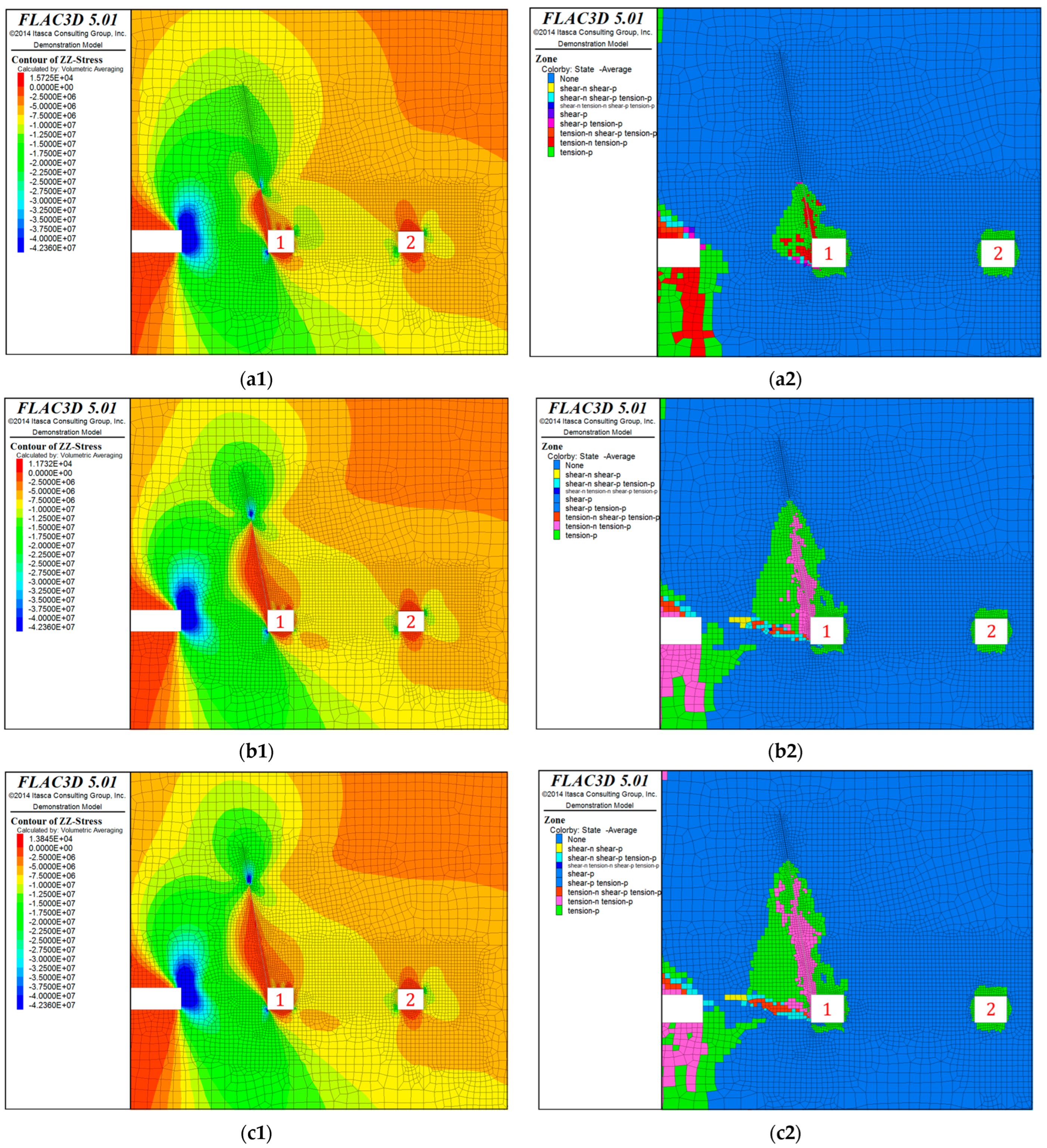

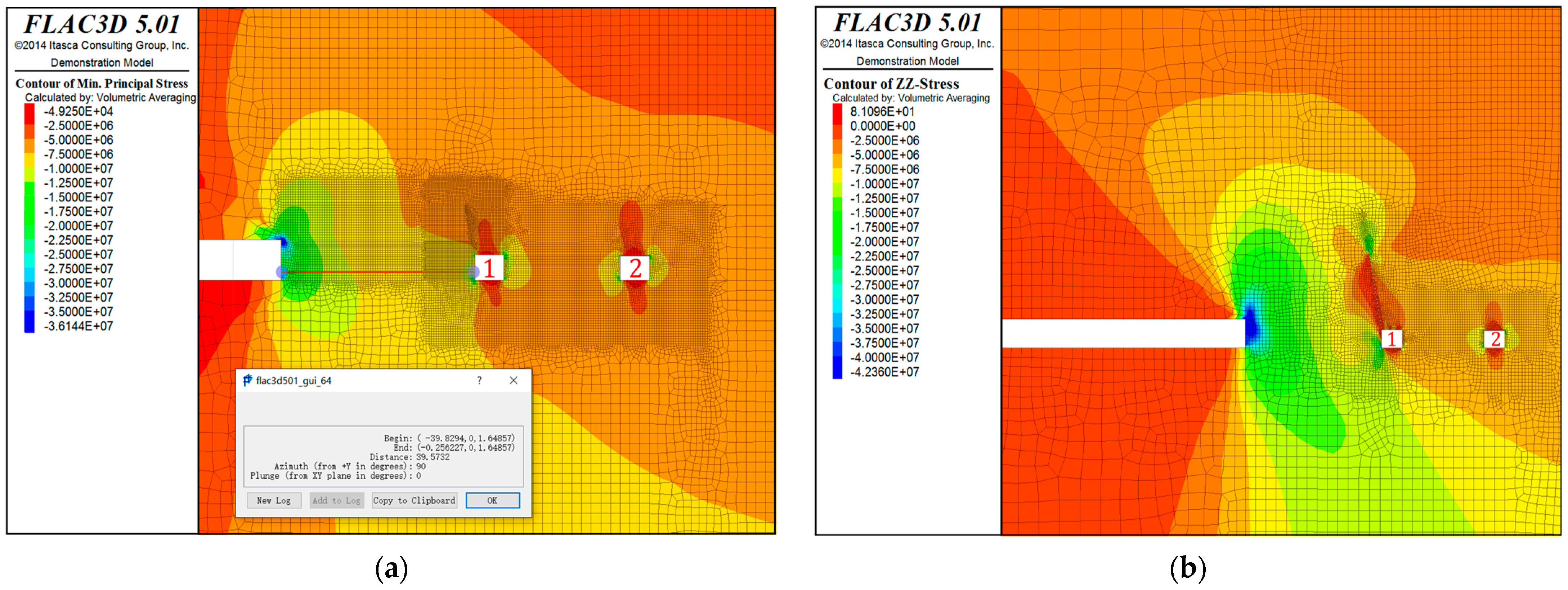
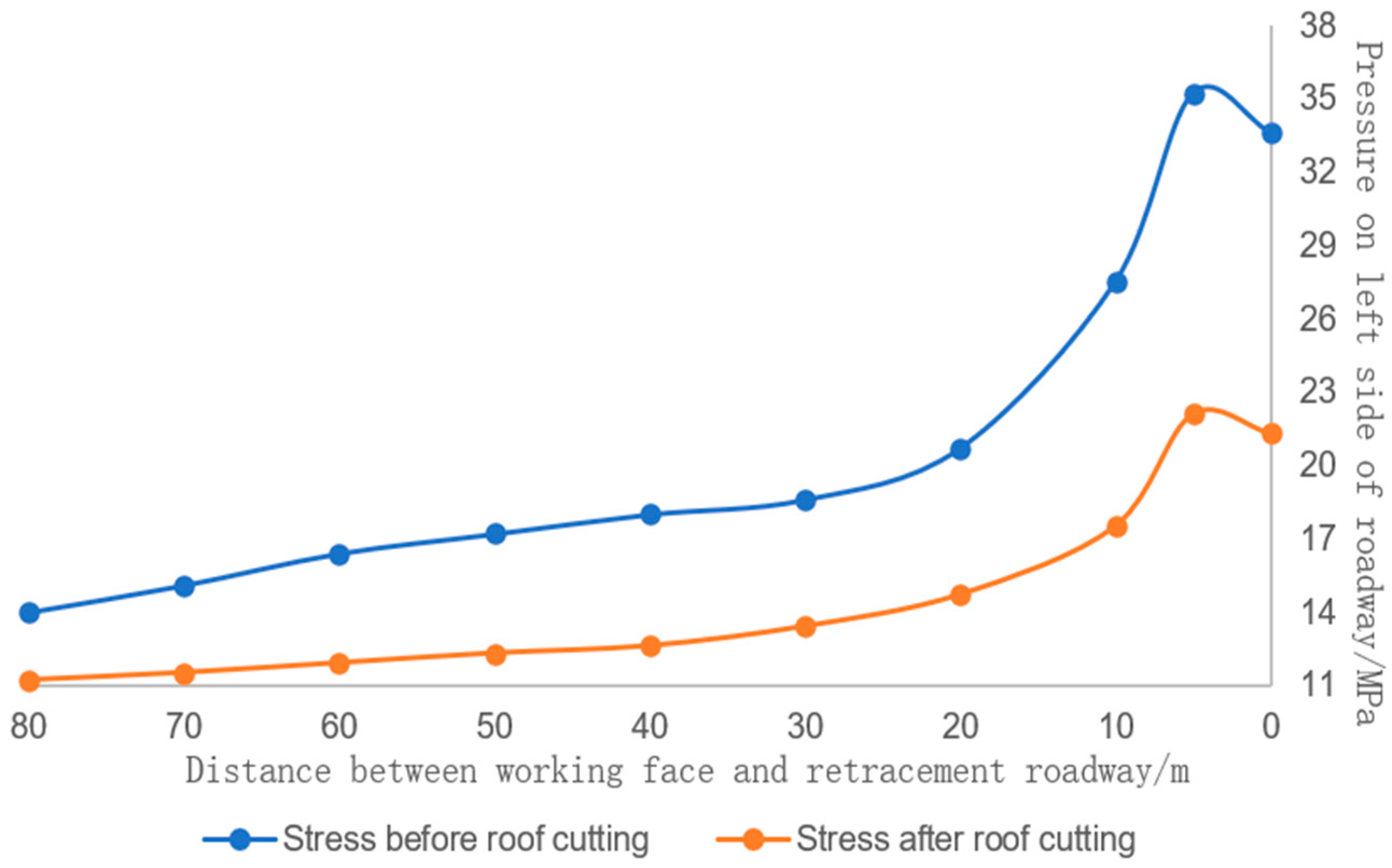
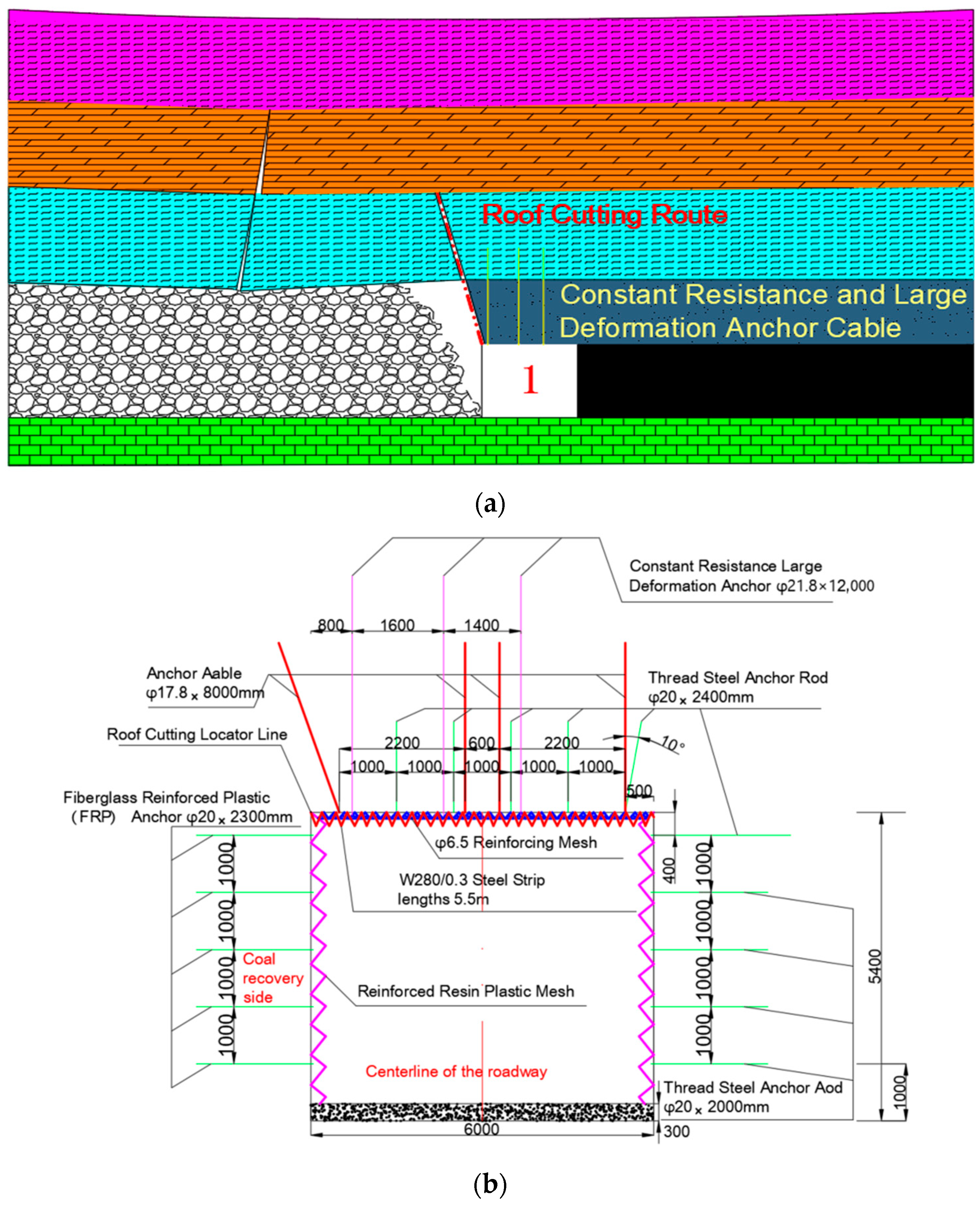
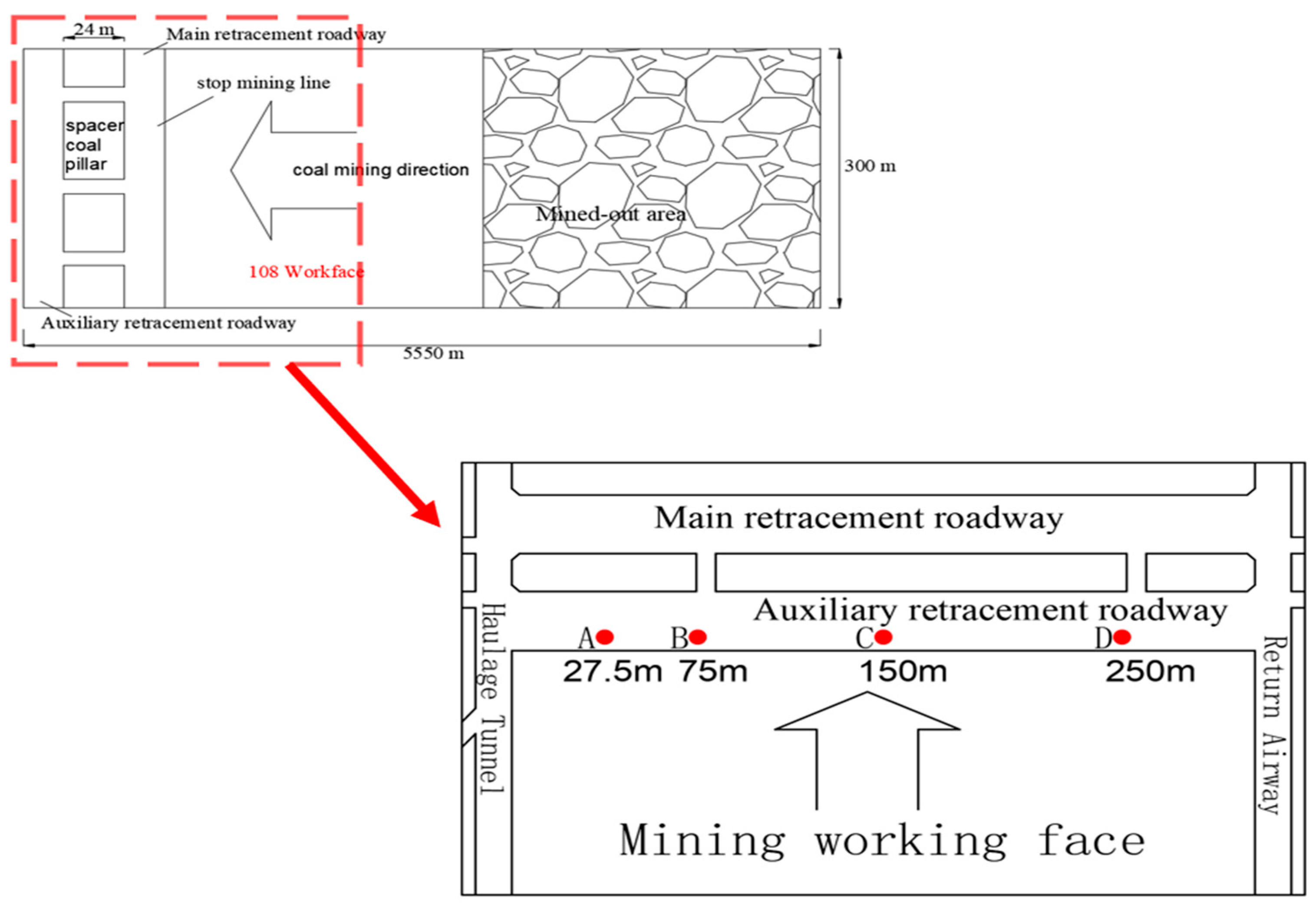

| Lithology | Densities/kg/m3 | Elastic Modulus/GPa | Tensile Strength/MPa | Cohesion /MPa | Angle of Internal Friction /° |
|---|---|---|---|---|---|
| Medium sandstone | 2653 | 12.5 | 4.6 | 2.5 | 31 |
| Mudstone | 2589 | 8.67 | 2.55 | 1.7 | 25 |
| Coarse Sandstone | 2813 | 12.35 | 6.5 | 2.7 | 20 |
| Siltstone | 2680 | 16.5 | 6.97 | 1.3 | 21 |
| Coal seam | 1390 | 1.68 | 1.1 | 1.2 | 19 |
| Thickness | 2531 | 14.6 | 6.58 | 2.0 | 32 |
Disclaimer/Publisher’s Note: The statements, opinions and data contained in all publications are solely those of the individual author(s) and contributor(s) and not of MDPI and/or the editor(s). MDPI and/or the editor(s) disclaim responsibility for any injury to people or property resulting from any ideas, methods, instructions or products referred to in the content. |
© 2024 by the authors. Licensee MDPI, Basel, Switzerland. This article is an open access article distributed under the terms and conditions of the Creative Commons Attribution (CC BY) license (https://creativecommons.org/licenses/by/4.0/).
Share and Cite
Peng, L.; Liu, W.; Peng, C. Study on Roof-Cutting and Support of a Retreating Roadway under the Double Influence of Large Mining Heights. Appl. Sci. 2024, 14, 7946. https://doi.org/10.3390/app14177946
Peng L, Liu W, Peng C. Study on Roof-Cutting and Support of a Retreating Roadway under the Double Influence of Large Mining Heights. Applied Sciences. 2024; 14(17):7946. https://doi.org/10.3390/app14177946
Chicago/Turabian StylePeng, Linjun, Weidong Liu, and Chengyuan Peng. 2024. "Study on Roof-Cutting and Support of a Retreating Roadway under the Double Influence of Large Mining Heights" Applied Sciences 14, no. 17: 7946. https://doi.org/10.3390/app14177946





